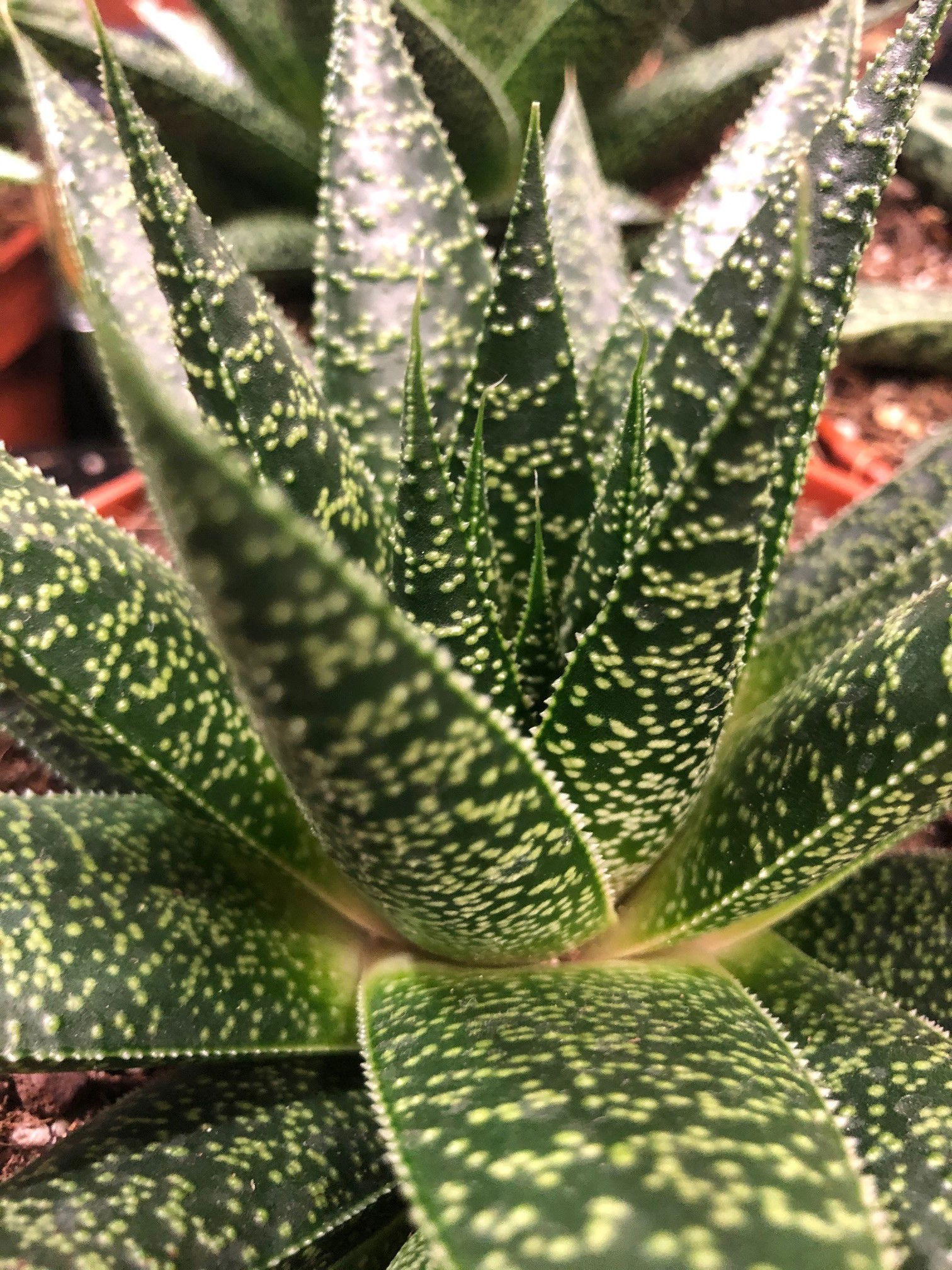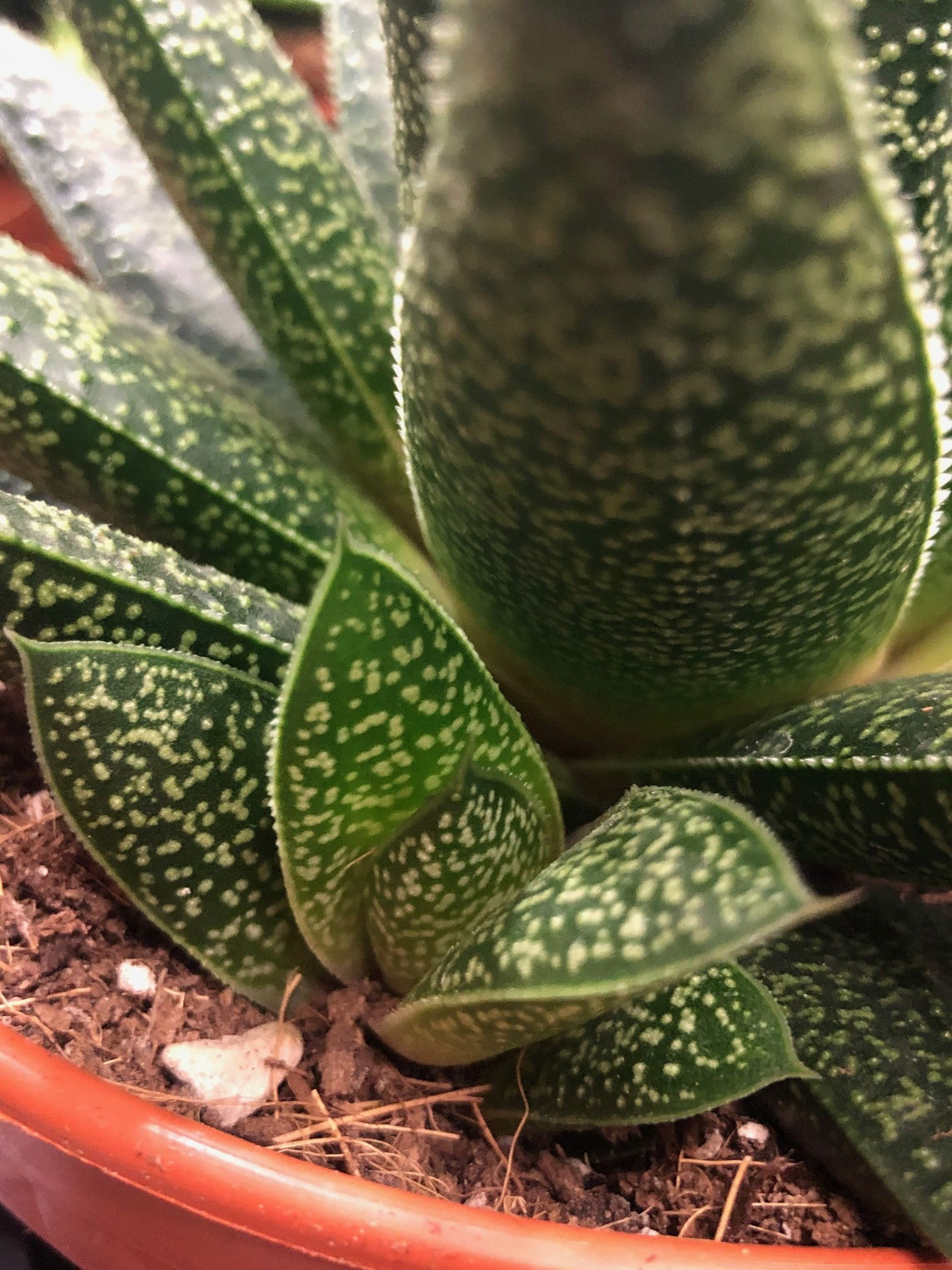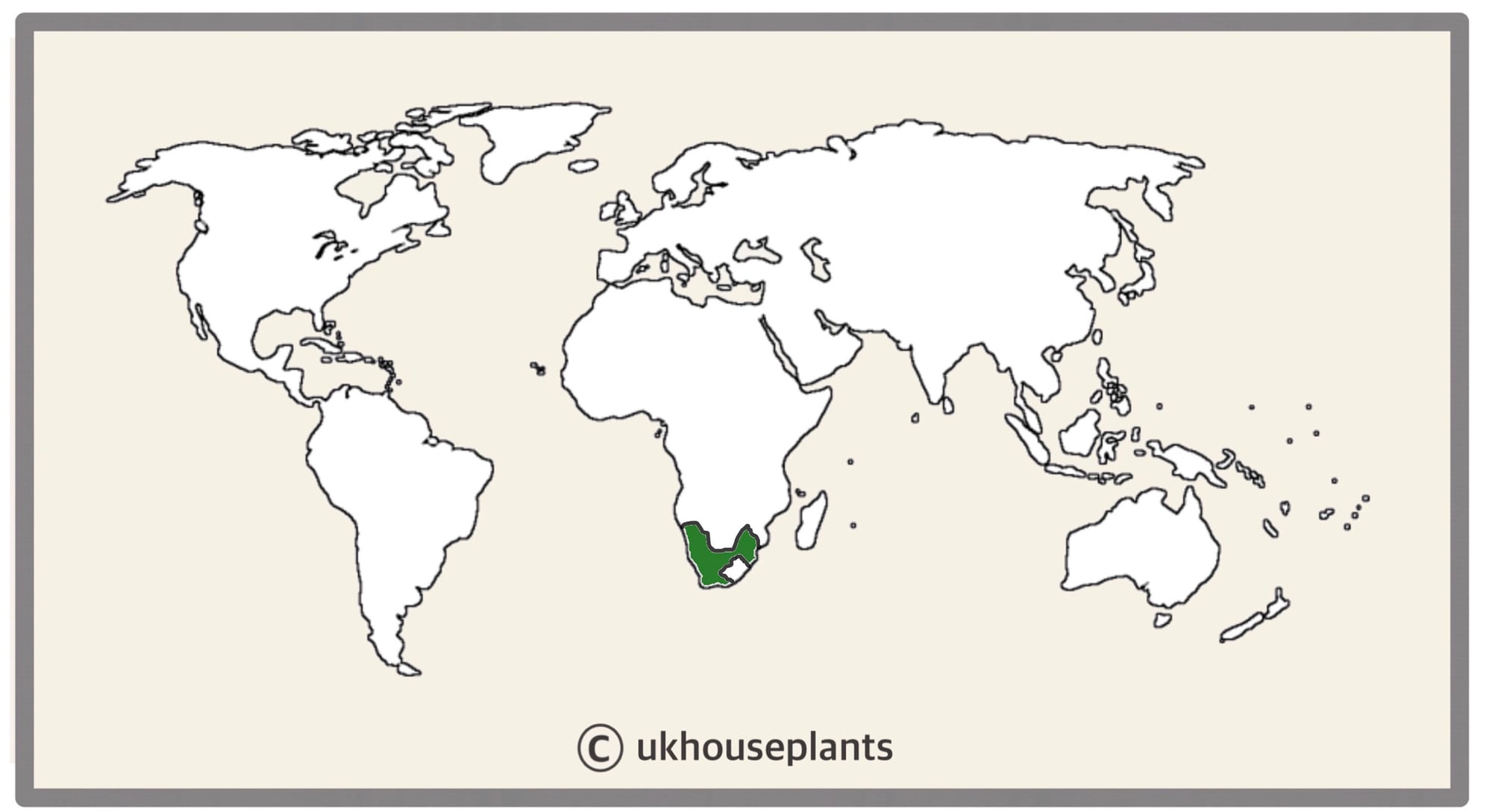
Gasteria duval
Contents
- Top Tips
- Location, Water, Humidity & Fertilisation
- Dormancy Care & Annual Flowers
- Common Issues
- Origins, Temperature, Propagation, Repotting & Toxicity
Need the answer to a specific plant query? Book a 1-to-1 video call with THE HOUSEPLANT DOCTOR™, the website's friendly author, to overcome and address your niggling problem! Available on iMessage, WhatsApp, Facebook Messenger & more.
Top Tips & Info
- Care Difficulty - Easy
- A few hours of morning or evening sun is mandatory, especially in the winter months.
- Gasteria must endure periods of droughts in between waters - if you're stuck with when to water it, think of the ukhouseplants' phrase of 'Drenches Between Droughts'.
- Be careful when watering - allowing excess moisture to sit in the cubbyholes of the stem will result in diseases like southern blight and 'heart rot'.
- Fertilise every two or three months using either a 'Cactus' or 'Houseplant' labelled feed.
- Repot every two to three years during the spring, using a 'Cactus & Succulent' potting mix. This is the perfect time to propagate the small offshoots that'll form at the base of the crown if you're looking to double your stock of Gasteria collection. Scroll down to 'Propagation' to learn more!
Location & Light - 🔸🔸🔸
Gasteria are best kept in a location with a few hours of either morning or evening sunlight to promote better growth habits. Dark locations, like several metres from a light source, must be avoided for the prevention of 'heart rot' and over-watering. If your specimen begins to develop a discoloured white crown, this is usually down to too little light. Newly-propagated 'pups' must not receive sunlight for the first few weeks as their insufficient root systems won't soak enough moisture to survive the harsh rays.
Water - 🔸
Less is more with Gasteria. Allow ALL of the soil to dry in between waters, reducing this to once every few weeks in the autumn and winter. One word of advice is never to allow excess moisture to settle either in the actual crown of the plant or underneath the pot, as both will cause southern blight or even black rot. Under-watering symptoms include drooping leaves, stunted growth, and drying leaves; these can be a range of different issues, including forgetfulness, too much sunlight, or the plant being pot-bound. Over-watering symptoms include root rot, a rotting base, or sudden plant death. Gasteria must have sufficient light levels (at least two hours of direct sunlight a day) to counteract the chance of root rot. For more severe cases, click on this link below to learn about how to address root rot.
Humidity -
This is not a factor; however, if the Gasteria is situated indoors, a quick hose down from time to time will reduce the number of dust particles covering its leaves.
Fertilisation - 🔸
Fertilise every two months during the growing period and every three months in the autumn & winter to replicate its dormancy period. Although a 'Houseplant' fertiliser will still do the job, we'd recommend using a specific 'Cactus' labelled feed as it'll support the vital thirteen nutrients that this species will need to grow.
Dormancy Care & Annual Flowers
Provide a cool autumn and winter period around 15℃ (59℉) to reinforce its dormancy. Keep the roots pot-bound to add further stress onto the specimen, which in turn will significantly heighten the chance of flowering. Blooms will generally appear in the early spring, during the active growth season and heightened temperature. The following steps should be taken from early autumn until the end of winter, but can be done throughout the year if you're extra keen for their fantastic blooms!
Sunlight & Location
Be sure to provide a bright location with a few hours of direct sun. Although the winter rays won't necessarily hurt the plant, be careful not to fall in the trap of sun-scorch and severe dehydration. Avoid deep shade and the use of artificial lighting at night or locations that boast temperatures higher than 18℃ (64℉).
Hydration
Reduce waters so that ALL of the soil becomes dry for several weeks. It's essential to keep them on the drier side to life, as they'll think that hard times are ahead and therefore will need to pass its genes on to the next generation.
Occasional Feeds
During the autumn and winter, fertilisation should be performed every two months with a 'Cactus' feed. While the flowers are in development or in bloom, use a Tomato fertiliser to provide fortnightly nourishment of potassium, at monthly intervals.
Reduce Everything
This is to remind you that everything needs to be reduced - especially the watering and temperature.
Temperature
This is the most significant step; reduce the temperature down by around 5℃ compared to the summertime or place in a room that's between 12º - 15℃ (52º - 59℉). You'll be at a significant disadvantage if the ambient temperature is kept constant throughout the year, as Gasteria will only respond in locations that have daily fluctuations of around 5℃. Never exceed the minimum temperature as it may lead to plant death or yellowed foliage at a bare minimum. If these steps are followed successfully, you could see a show of blooms in the following summer - but remember, dealing with nature may not always provide the results you'd relish!
Common Issues with Gasteria
Over-watering is the most common issue, with typical signs including a softened yellow or softened centre and browned foliage. There must be periods of droughts to replicate the habitats of the south African deserts, as well as limiting the chance of diseases. Avoid waterlogging as there's no point fulfilling the phrase 'drenches between droughts' if the base of the pot is submerged. For more information about over-watering related issues, be sure to click on this link.
A pale centre and deformed growth are typical signs of too little light. Offer at least an hour of direct sunlight, especially in the winter months, to provide the vital nutrients that'll be converted into plant sugars.
Reddened leaves are the product of too much sunlight, most common during the height of summer. A pigmentation called 'Carotenoids' will alter the appearance of your plant to counteract the harsh effects of the UV rays. This doesn't mean it'll die, it just a behaviour to keep it from burning in the sun. THE HOUSEPLANT DOCTOR™ recommends to relocate in another windowsill that offers indirect sunlight, like a north-west, north or north-east facing window.
Over-supplementing an Gasteria will bring nothing but grief in the likes of yellowing leaves and weak, dramatic growth. Although a six-weekly feed is an excellent way to promote good health, dry soil and fertiliser salts will quickly lead to the burning of roots. The advice for this issue is to pre-moisten the soil beforehand and reduce the frequency of fertilisations somewhat.
Origins
Gasteria consists of over twenty species, originating from semi-deserted areas of South Africa. The genus was first described back in the mid 19th century by Joseph Duval-Jouve, who named it after the stomach-churning consequences when a specimen is digest by an animal.
Temperature
10°C - 25°C (50° - 78°F)
H1b - can be grown outdoors in summer in a sheltered location, but is fine to remain indoors. If you decide to bring this houseplant outdoors, do not allow it to endure more than an hour of direct sunlight a day as this will burn the leaves. Regularly keep an eye out for pests, especially when re-introducing it back into the home.
Spread
Most species will reach heights of 0.4m in height and 0.8m in width, with the ultimate height being reached within 5 - 8 years.
Pruning
Remove yellow or dying leaves, and plant debris to encourage better-growing conditions. While pruning, always use clean utensils or shears to reduce the chance of bacterial and fungal diseases. Never cut through yellowed tissue as this may cause further damage in the likes of diseases or bacterial infections. Remember to make clean incisions as too-damaged wounds may shock the plant, causing weakened growth and a decline in health.
Propagation
Via Seed, Offset Division or Leaf/Stem Cuttings.

Offset (Pup) Division - For this method, it's best to divide in spring or summer and once the offshoots are at least a quarter of the mother plant's size. Remove its pot and place your hand in between the junction that connects the two; soil may have to be brushed away to get a better grip. Gently push the pup downwards while supporting the mother plant until you hear a snap. Cautiously separate the root systems, keeping great care in keeping them damage-free. Place the new plantlet in a small pot with a well-draining potting mix, much similar to the original soil, and maintain the same care routines. 'Cactus & Succulent' compost is best, or you can make your own using multipurpose compost with added grit or perlite. Provide a bright setting with temperatures around 18°C (64°F) with the majority of the soil drying out in between waters. New leaves should emerge within the six weeks, as long as the soil is kept on the drier to life.
Leaf Cuttings (Easy) - Leaves that are halfway along the vine have the most potential due to its size and maturity. Gently place your fingers between the mother's stem and the leaf's base, pulling it downwards until you hear a snap. Ensure the wound is wholly intact with no damage, as a bruise or tear will result in unsuccessful propagation. Set the leaf ON TOP OF a bed of moist 'Cactus & Succulent' compost for root growth. Not only will this callus the wound (to prevent disease), but it'll also speed up the propagation process considerably. Once there are signs of small roots developing on the node, place it one third into the compost, at a slight angle. Provide a bright setting with temperatures around 18°C (64°F) with the majority of the soil drying out in between waters. New leaves should emerge within a month or two, thus signalling the start of its independent life!
Stem Cuttings (Easy) - Using a clean pair of scissors, cut a 10cm (4 - 5 inches) section off the stem's end. Be sure to use a fresh, damage or pest-free piece as unhealthy divisions are more likely to fail. Remove the older half of the leaves, so that the stem's lower portion is bare, to speed the process of root development. Purchase a 'Cactus & Succulent' compost and vertically push the cutting's base into the soil, avoiding the risk of covering the actual foliage with soil. Situate the cutting in a bright, indirect setting with temperatures above 18°C (64°F). As the roots will develop first, remove the bag and treat it as an adult specimen once there are signs of new foliar development.
Flowers
Warm-coloured flowers are arranged by a pendulous spike that'll develop each year, reaching up to 30cm in height. Each flower can last up to several days during the late winter to mid springtime, with the overall blooming process spanning several weeks. Whilst the plant is flowering, be sure to keep the plant on the drier side to life in a sun-filled environment (windowsill, semi-heated conservatory, etc.).
Repotting
Repot every two to three years in the spring, using a 'Cactus & Succulent' labelled potting mix and the next sized pot with adequate drainage. Hydrate the plant 24hrs before tinkering with the roots to prevent the risk of transplant shock which would otherwise cause lower yellowing leaves, stunted growth and even plant death in some extreme cases.
Note - At ukhouseplants, we class Gasteria succulents as 'family plants', whereby they actually grow better when the pups are still attached to the mother plant. The individual offsets will also produce their own root system, which in turn soaks up excess moisture in the pot that would otherwise pose a risk of root rot when over-watered (if your Gasteria mother plant is growing alone after being propagated).
Pests & Diseases
Keep an eye out for scale, spider mites & mealybugs. For more info on how to address any of these issues, hit this link. Common diseases with Gasteria are root, crown or heart rot, sun-scald, soft rot, scabs, nematodes, leaf-spot disease and powdery mildew. Identifying Common Houseplant Diseases & Viruses
Toxicity
This genus is classified as poisonous. If parts of the plants are eaten, vomiting, nausea and a loss of appetite could occur. Consumption of large quantities must be dealt with quickly; acquire medical assistance for further information.
Retail Locations
B&Q, Dobbies, Homebase, IKEA, Online Stores.
Book a 1-to-1 Call with Joe Bagley
If you need further advice with your houseplants, book an advice call with ukhouseplants' friendly and expert writer today! This can be done via a video or audio call on most apps, including Facebook, FaceTime & Skype. A ten-minute call costs £5.99 (US$7), or £15.99 for thirty minutes. You can ask multiple questions, including queries on plants, pests, terrariums, repotting advice and anything in between. Please consider supporting this service to keep ukhouseplants thriving!
